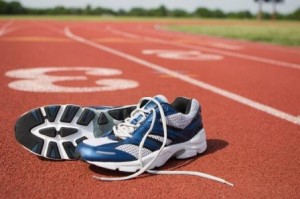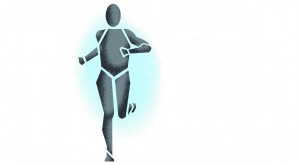 When people think about low-paying (or non-paying) entry-level jobs, professional athletes usually don’t come to mind. Two blog posts by the Track and Field Athletes’ Association this year highlighted the shallow financial opportunities for elite track and field athletes; the necessity of combining multiple sponsorships, funding sources and day jobs for elite athletes; and the reality that even with a full-time professional contract, many athletes still face a deficit between their salary and the costs of being an elite athlete.
When people think about low-paying (or non-paying) entry-level jobs, professional athletes usually don’t come to mind. Two blog posts by the Track and Field Athletes’ Association this year highlighted the shallow financial opportunities for elite track and field athletes; the necessity of combining multiple sponsorships, funding sources and day jobs for elite athletes; and the reality that even with a full-time professional contract, many athletes still face a deficit between their salary and the costs of being an elite athlete.
Track and field athletes face several challenges not found in other sports. No other sport comes close to running for the levels of participation at the recreational and grass-roots level, yet track and field is nearly invisible as a spectator sport in America. Tens of thousands of people will pay hundreds of dollars to register for and travel to races such as the New York or Chicago marathons, or the now-international Rock and Roll Marathon Series. But judging by ESPN’s programming choices, poker and competitive eating are more popular and more lucrative spectator sports than track and field.
As a result, participant runners do not connect and identify with the sport’s elites. In fact, many runners can’t even identify the sport’s elites. Earlier this year, 14,000 people ran the Livestrong Austin Marathon and Half-Marathon. Last month, former University of Texas standout and longtime Austin resident Leo Manzano won the Olympic silver medal in the 1500-meter race, and yet he still has fewer than 12,000 Facebook followers (which, for track and field, is actually pretty good!).
Like other individual sports, track and field athletes must build their own notoriety without the benefit of the publicity, association and ready-made fan base of a team. Whereas tennis players and golfers often compete into their 30s and 40s, respectively, track and field athletes have a much shorter career. This is not just because of the divergence of competitive demands with physiological realities, but also because of the low financial return on investment for all but the top few athletes in each discipline. The need to build a brand alongside one’s athletic portfolio takes on extra importance for a track and field athlete, and can be the difference between a career cut short by financial struggles and a career that follows the athlete’s competitive potential.
Third, track and field’s governing bodies strictly limit the number, size and placement of sponsor logos on an athlete’s competition apparel. A holdover from the era of amateur athletics and concretized by the governing bodies’ bylaws and regulations, athletes cannot properly advertise for their sponsors when competing on the world’s largest stages. The sponsor’s exposure is limited to smaller venues and competitions, reducing the number and value of an athlete’s potential sponsors.
Track and field athletes have a short amount of time with few opportunities and significant obstacles to build a marketable and sustainable brand. Balanced against these negatives are the legions of running enthusiasts who are willing to spend money on the sport but have yet to be converted from participants to fans. Here are three ways track and field athletes can effectively and efficiently build their brand and their fan base by using the people and resources already in the running community:
 1) Association through sponsorships
1) Association through sponsorships
The salience of brand association between fan, athlete and sponsor is especially strong in running. When a recreational runner buys a product based on an elite athlete’s endorsement, they are going to use that product for the same purpose, during the same activity, maybe even during the same race as the pro. The product’s relationship between professional and recreational runner is not just association through the brand, but an identification of the same need and function fulfilled by that product. The fan uses the product not because the athlete does, but because the two are going to do the same thing with it.
Small companies and start-ups are taking a more active role in sponsoring track and field athletes, and this offers the potential for emerging athletes and companies to identify and develop their brands in tandem. A more diverse band of sponsor companies in the running market space will present more opportunities not only for elite sponsorship but for everyday runners to find the athlete-company partnership with whom they most closely identify, therefore reducing the distance between participants and professionals.
 2) Social media interaction
2) Social media interaction
Track and field athletes and fans are some of the most savvy social media users in the sports world because their sport is so underpublicized. Social media is often the only media coverage a track and field athlete or discipline will receive. Track and field athletes have made extensive use of social media to bring to light their financial plight and the institutional constraints on their livelihood.
During the London Olympics, #WeDemandChange and #Rule40 were among Twitter’s highest trending tags as some of America’s most decorated and famous track and field athletes protested the blackout restrictions on commercial communications. Apparel manufacturer and emerging athlete sponsor Oiselle spearheaded one of the most intriguing social media developments of the Olympics. Oiselle posted a list of track and field athletes’ sponsors, and encouraged fans to tweet on behalf of the sponsors during the athletes’ events using the hashtag #bsblackout, to circumvent Rule 40’s restrictions. This was an individual sponsor with no direct skin in the fight (no Oiselle athletes competed in the Games) igniting the fan base in support of all sponsors and all athletes, underscoring the close relationship between these three communities within the track and field industry.
Social media also offers a great opportunity for professional athletes to connect with recreational runners, highlighting the similarities in the experience of the sport as well as the differences that make them elite. A professional track and field athlete tweeting the mileage on his morning run is a chance for a potential fan to say “I’ve run that route before!” or “Hey, I actually ran further than him today!” Athletes can share their post-workout meals, pre-race rituals and training pointers to aspiring youth runners wondering what may await them at the pro level; and to recreational runners seeking inspiration from and identification with the world’s best. Updates throughout the day, over the course of weeks and months, provide a virtual training log that athletes can share with their fans. As fans identify with aspects of the athletes’ training on a day-to-day basis, over time they appreciate the volume, intensity and dedication required to be a professional runner.
 3) Track Clubs: A continuum of athletes
3) Track Clubs: A continuum of athletes
Many elite runners are part of a running club that provides a variety of services including coaching, facility access, sports medicine, apparel and financial support. Most clubs have a large “Open”-level membership of recreational runners who join the club for coaching or for the community of fellow runners. The open members’ fees comprise a large portion of the club’s revenue, which is used to support the club’s elite athletes. Since the open members are contributing financially to the professional athletes, they should be the professionals’ first and strongest fan base.
The club presents numerous outlets for direct interactions between professionals and their prospective and current fans. The professional athletes can show up at open level training runs, may attend the same social events, and can host open practices so club members on one end of the athletic spectrum can see what their fellow members are doing at the other end.
Track and field has yet to take advantage of the market for branded apparel, but within the club system this is a simple way to bridge the gap between levels of athletes. Whereas most people who wear their favorite team’s jersey have no affiliation with the team, a running club member wearing their club uniform has a direct link to the professional athlete wearing the same thing. Track and field offers the unique opportunity to convert participants to fans by first making those fans teammates with the professionals.
Running is one of the few sports where professionals and casual participants truly share the sporting experience: all runners race the same course at the same time on the same day. By exploiting the sameness of the running experience – both on race day and every day – professional athletes can bridge the gap and turn 20,000 sweating marathoners into 20,000 screaming fans.


@glenncritchley Thanks mate … some similar concpets